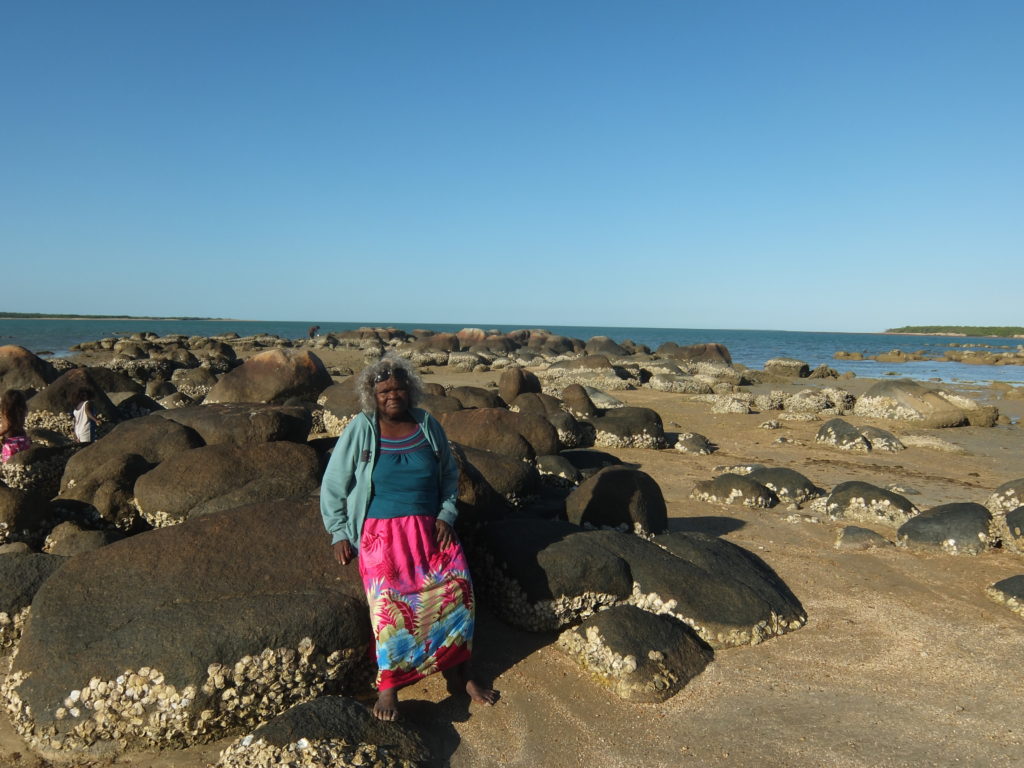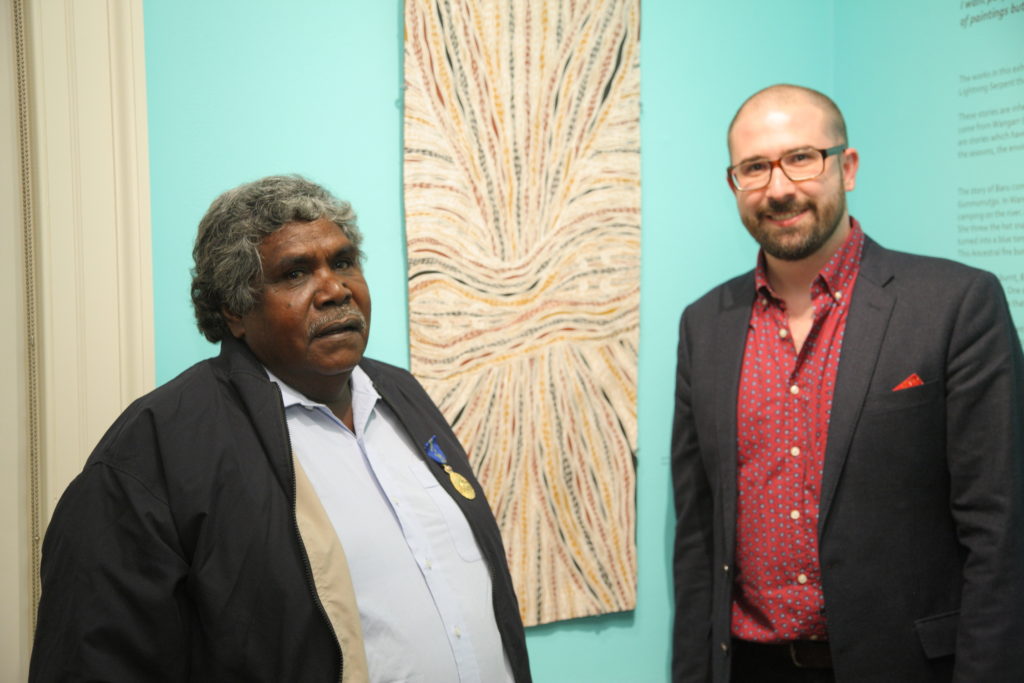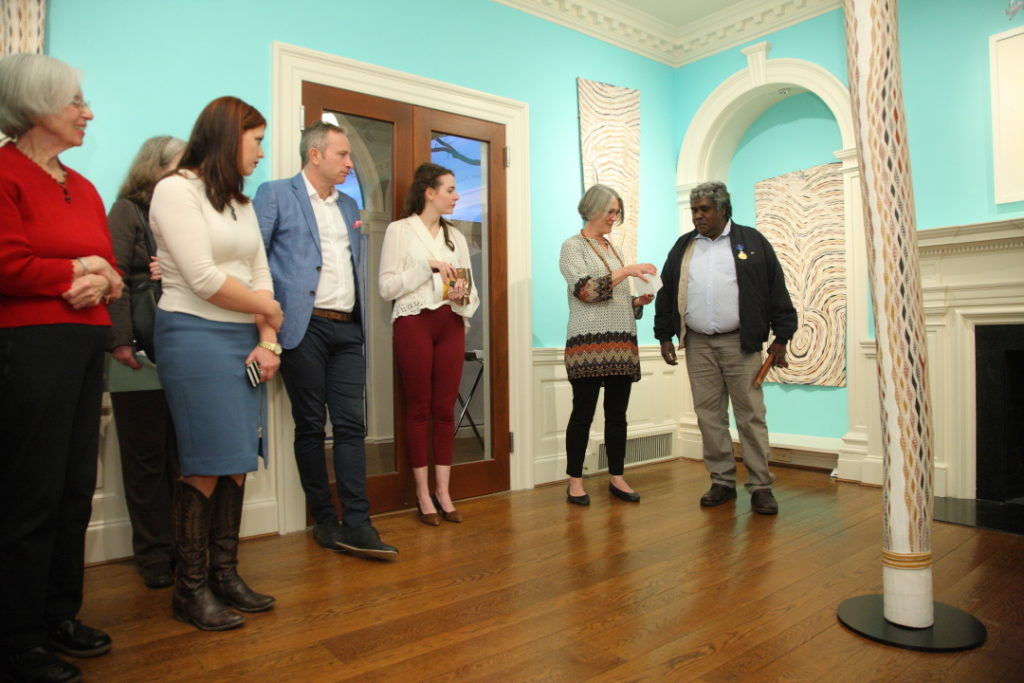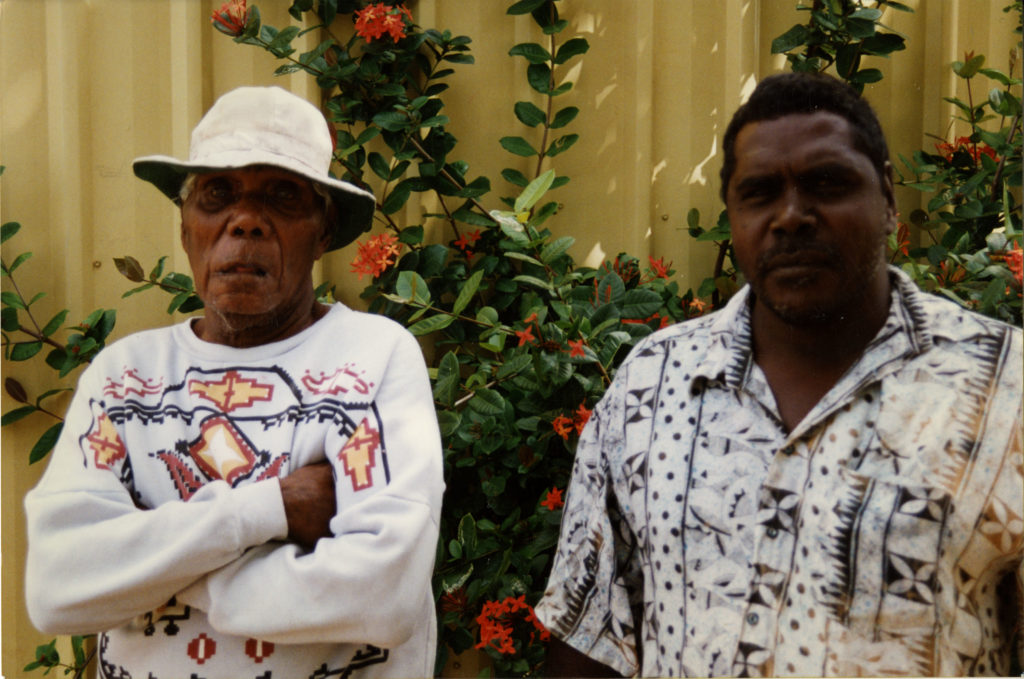
I had no idea quite how eventful October 2015 would be when I headed out from my home in Pittsburgh for my first visit to the Kluge-Ruhe Aboriginal Art Collection. Five months earlier, I had been in Yirrkala undertaking research for my PhD thesis. This had been a particularly eventful trip. Over the past year, I had become good friends with Kade McDonald—the art-coordinator at Buku-Larrŋgay Mulka Art Centre—and he had promised me that this trip we would go out bush on a special camping trip.
My research was on one of the senior women at the art centre—Noŋgirrŋa Marawili—who was just emerging as one of the most powerful contemporary painters at the centre. Kade had a close relationship to Noŋgirrŋa. Having been “adopted” by Noŋgirrŋa’s daughter Marrnyula, he refers to Noŋgirrŋa his Ŋändi (mother). It made sense, then, that any camping trip would include this extended family. When we asked Noŋgirrŋa where she might want to go camping, she was resolute: Baratjala! In recent years, this remote bay on the Gulf of Carpentaria had been her persistent muse. She had grown up there with her father, the warrior Munḏukul and his many wives and children. Unfortunately, it was a place rarely visited in recent years. The Rangers told us it would be a difficult trip, warning that recent cyclones meant it might be impossible to access the site. We relayed this information to Noŋgirrŋa: who looked at us sternly. “No,’ she said with the full force of her matriarchal authority. “You boys are taking me to Baratjala.” The story of that trip is one for another time—I wrote about it in a different essay on Noŋgirrŋa, as did Annie Studd, the manager of the Yirrkala Print Studio, who aptly described it as “the best weekend I have had in ages. Maybe EVER.”
This weekend was in the forefront of mind when I drove down to Charlottesville for the opening of Djambawa Marawili’s exhibition where the water moves, where it rests curated by Kimberley Moulton. I had met Djambawa twice before—on an earlier trip to Yirrkala, I’d had the privilege of previewing the works that were heading to Charlottesville while Djambawa patiently tried to explain to me both the profound connection and difference between his works and those of his classificatory sister Noŋgirrŋa (Noŋgirrŋa’s father Mundukuḻ is the older brother of Djambawa’s father Wakuthi). It is hard to explain what it is like to sit and listen to Djambawa. He speaks slowly, choosing his words with great care, his rich baritone perfectly suited to the profundity of his insights. In thirty minutes in the art centre with Djambawa, I think I learned more about Noŋgirrŋa’s art than I have in the past three years of research. Needless to say, I was extremely excited about the opportunity to recommence this conversation.

In Charlottesville, I quickly encountered the hospitality that Kluge-Ruhe is known for. Margo Smith and the staff were so welcoming and made me feel immediately part of the team. On the first day, I was taken to lunch with Djambawa and the team, who were incredibly generous with their time considering that they had an opening that evening! At the end of lunch, Djambawa asked if there were somewhere he could get new shoes—something more formal for his forthcoming visit with Ambassador Kim Beazley. Being at a loose end, I offered to take him shopping. Little did Djambawa know that my knowledge of the Charlottesville area was even less than his! But, off we went!

Djambawa is a deep thinker: and the trip to America had clearly set him in a philosophical direction. In the car, he spoke at length about young artists, their emergence as leaders, as well as the shifting dynamics within contemporary women’s paintings. He spoke with particular respect for “those two old ladies” who worked at the art centre—referring to Noŋgirrŋa and Mulkuṉ Wirrpanda—who represented the last generation to experience life before the arrival of missionaries in North East Arnhem Land. But the dominant theme of his conversation was the need for young people to return to their homelands where they could learn the deep and sacred meanings of their country.
When we returned to the museum, Margo Smith had a special surprise waiting for us. It was a binder. A simple, white, three-ringed binder. When we opened it, we could hardly believe our eyes. Inside were pages and pages of photographs documenting the creation of the 1996 John W. Kluge Yirrkala commission. There were images of legends such as Gawirrin Gumana, Djutatjuta Munuŋgurr and Mowarra Ganambarr, but also of the next generation: those young guns who were now the clan leaders, such as Manydjarri Ganambarr, Dhukal Wirrpanda, and of course, Djambawa Marawili.

Djambawa was visibly moved by the images he found. He poured over them carefully, laughing at images of his peers in their younger days; reflecting on the wisdom he had learned from older men and how he had assisted other artists finishing their commissions. But there was one photo in particular that he lingered on. It showed Djambawa alongside his father Wakuthi. The older man looked tired, his face gaunt—the younger man radiant with youth. But both were clearly proud of the monumental painting they stood before. Nearly 11 feet tall, Djambawa’s painting Maḏarrpa Miny’tji is monumental in every sense of the word. In 1996 it would be awarded the bark painting prize in the National Aboriginal and Torres Strait Islander Art Awards. But clearly it held a deeper significance to Djambawa. Later, he described it this way:
They gave me that award, to thank me for these beautiful designs. It gave them pleasure to see this work that came from Yolŋu artists, but for me its significance is that these designs were put into our Country by the ancestors and then passed on down to us by our grandfathers and great-grandfathers, so that now we paint them.
Djambawa Marawili AM
In Charlottesville, he told us how his father had sat by his side during the painting of Maḏarrpa Miny’tji—how he had supervised him to ensure it was “proper” and directed him as laid down the designs. For many decades, Wakuthi had been the powerful leader of the Maḏarrpa clan, establishing their homelands at Bäniyala to keep their connection to Country and Law strong. Now he was passing the reins to his son Djambawa.